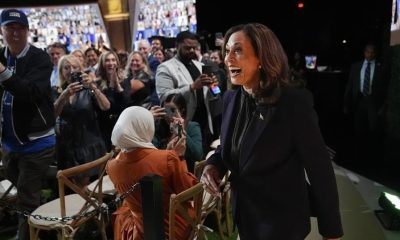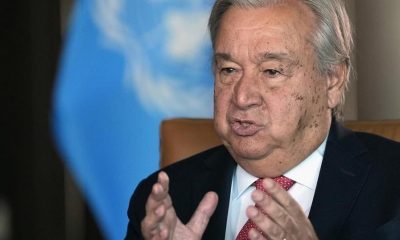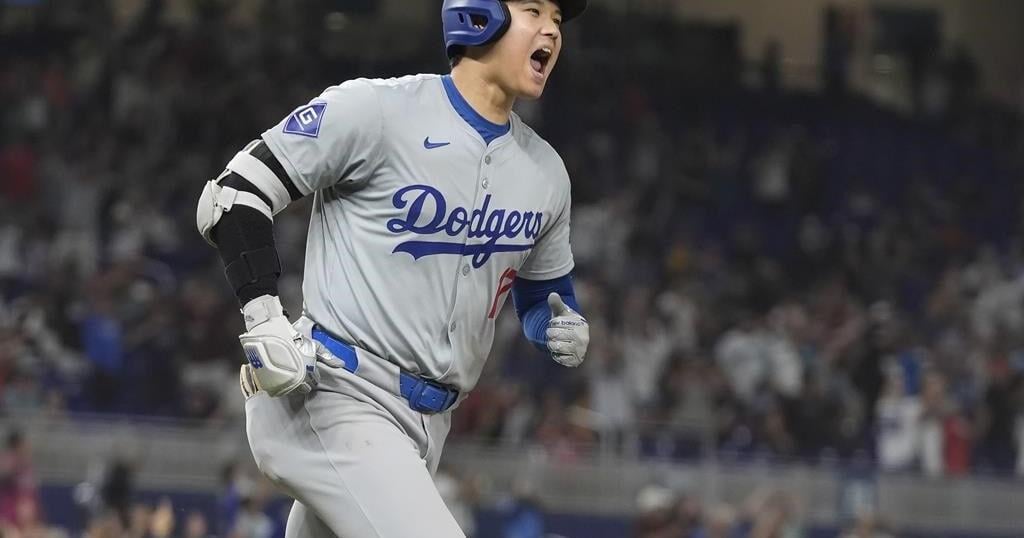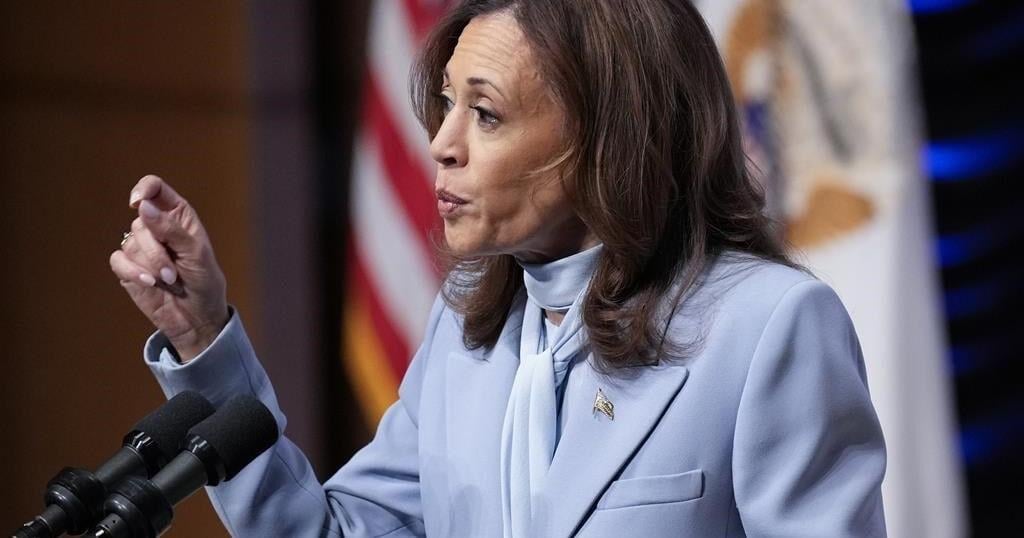Both major presidential candidates are making appearances Thursday meant to fire up their core supporters. Vice President Kamala Harris is participating in a livestream with Oprah Winfrey, who has endorsed Harris and spoke at the Democratic convention in August. Donald Trump will be in Washington to address a “Fighting Anti-Semitism in America” evening event with Miriam Adelson, a co-owner of the NBA’s Dallas Mavericks and widow of billionaire casino magnate Sheldon Adelson, who founded the Las Vegas Sands casino and was one of the Republican Party’s largest donors.
Follow the AP’s Election 2024 coverage at: https://apnews.com/hub/election-2024.
Here’s the latest:
Harris talks openly about her gun ownership
Vice President Kamala Harris has grown more open about her gun ownership in recent weeks, but on Thursday she for the first time said what she’d do with the handgun she owns.
Speaking during a campaign event hosted by the talk show host Oprah Winfrey, Harris was addressing her efforts to cut down on violence and pass a new ban on assault-style weapons, when she referenced owning a handgun — surprising Winfrey.
“If somebody’s breaking into my house they’re gettin shot,” Harris added. She continued: “I probably shouldn’t have said that. My staff will deal with that later.”
Oprah and Kamala Harris host town hall
A live stream with Vice President Kamala Harris and talk show host Oprah Winfrey billed as a “Unite for America” rally kicked off with more than 230,000 viewers on YouTube alone even before Harris joined, as the Democrat looks to digital-first events to reach voters.
The event is hosted by Winfrey from suburban Michigan, one of this election’s key battlegrounds, and is leaning on celebrities like Brian Cranston, Jennifer Lopez, Chris Rock, and Meryl Streep, but also the stories of ordinary voters to promote Harris’s message.
“I want to bring my daughters to the White House to meet this Black woman president,” said comedian Chris Rock.
Trump speaks to Jewish leaders in D.C.
Donald Trump is appearing before Jewish leaders in Washington D.C. to talk about antisemitism.
But as the former president is wont to do, he’s taken a large detour at the top of his speech, name-checking his Republican allies in the crowd, discussing the Green New Deal “scam” and pontificating about his polling numbers at length.
Trump was roughly an hour late to his speech, which was slated to begin around 6 p.m.
“Kamala Harris has done absolutely nothing. She has not lifted a single finger to protect you, or protect your children, or even protect you with words… I’m here to tell you today that this ugly kind of antisemitic hate for all of us — bigotry and hate — will be turned back … starting at noon on Jan. 23rd,” he said.
“With your vote, I will be your protector and defender and I will be the best friend Jewish Americans have ever had in the White House.”
North Carolina representative reacts to Robinson media report
On Capitol Hill in Washington, Republican Rep. Richard Hudson of North Carolina, the chairman of the House GOP’s campaign committee, told reporters the report’s findings were “concerning.”
Republicans are trying a new approach to abortion in the race for Congress
In the most contested races for control of the U.S. House, many Republican candidates are speaking up about women’s rights to abortion access and reproductive care in new and surprising ways, a deliberate shift for a GOP blindsided by some political ramifications of the post-Roe v. Wade era.
Looking directly into the camera for ads, or penning personal op-eds in local newspapers, the Republicans are trying to distance themselves from some of the more aggressive anti-abortion ideas coming from their party and its allies. Instead, the Republican candidates are working quickly to spell out their own views separate from a GOP that for decades has worked to put restrictions on reproductive care.
It’s a remarkable about-face as the Republican Party works to prevent losses this November that could wipe out its majority control of the House. It comes in a fast-moving election season with high-profile and gripping stories of women’s lives being upended and endangered by abortion restrictions.
Read more here.
These evangelicals are voting their values — by backing Kamala Harris
Former President Donald Trump has heavily courted conservative evangelicals since his arrival on the political scene almost a decade ago. Now he is selling Trump-themed Bibles, touting the overturning of Roe v. Wade and imploring Christians to get out the vote for him.
Trump has maintained strong support among white evangelical voters. According to AP VoteCast, a sweeping survey of the electorate, about 8 in 10 white evangelical voters cast a ballot for him in 2020. But a small and diverse coalition of evangelicals is looking to pull their fellow believers away from the former president’s fold, offering not only an alternate candidate to support but an alternate vision for their faith altogether.
Grassroots groups like Evangelicals for Harris have run advertisements and Zoom call to shore up evangelical votes for the vice president. Despite some policy differences with Harris, they argue she is the better choice this election.
“I certainly don’t agree with her on all matters of policy,” said Lee Scott, who identifies as evangelical and is ordained in the mainline Presbyterian Church (U.S.A.). “I am pro-life. I am against abortion. But at the same time, she has a pro-family platform,” citing Harris’ education policies and promise to expand the child tax credit.
Read more here.
Trump begins to distance himself from Robinson
Trump’s campaign appears to be distancing itself from Robinson in the wake of the CNN reporting, which AP has not independently verified.
In a statement to AP, which reached out for comment on the reporting, Trump campaign spokeswoman Karoline Leavitt said that the GOP nominee’s campaign “is focused on winning the White House and saving this country,” calling North Carolina “a vital part of that plan.”
Leavitt went on to contrast Trump’s economic record with that of Harris, but did not mention Robinson by name or answer questions as to whether he would appear with Trump at a Saturday campaign rally in Wilmington, or had been invited to do so.
Harris’ campaign reminds voters of Trump’s ties to North Carolina Lt. Gov. Mark Robinson
As CNN published a report that Trump ally and North Carolina Lt. Gov. Mark Robinson posted strongly worded racial and sexual comments on an online message board, Harris’ campaign reminded voters of the gubernatorial nominee’s linkages to Trump.
In one X post, Harris’ campaign played video clips of Trump praising Robinson – including calling him “better than Martin Luther King” – over headlines from CNN’s reporting.
Another showed Robinson and Trump standing side-by-side giving Trump’s signature thumbs up pose, with the campaign adding a corresponding emoji to the post.
CNN reported Thursday that Robinson, who would become North Carolina’s first Black governor, attacked civil rights leader Martin Luther King Jr. in searing terms and once referred to himself as a “black NAZI.”
Robinson has stumped in North Carolina with Trump several times and spoke at this summer’s Republican National Convention. But he wasn’t with Vance as the GOP vice presidential nominee campaigned in Raleigh on Wednesday, and Trump’s campaign didn’t respond to a question seeking comment as to whether he would appear with the presidential nominee on Saturday in Wilmington.
Wisconsin election officials ask Supreme Court to determine Robert F. Kennedy Jr.’s ballot fate
Election officials in Wisconsin are asking the state’s liberal-controlled Supreme Court to decide whether independent Robert F. Kennedy Jr.’s name should stay on the presidential ballot without waiting for an appellate ruling.
Kennedy suspended his campaign in August and endorsed Donald Trump. He’s been trying to get his name off ballots in key battleground states like Wisconsin. A Dane County judge ruled Monday that state law mandates candidates must remain on the ballot unless they die. Kennedy has filed an appeal with the 2nd District Court of Appeals.
Attorneys for the Wisconsin Election Commission asked the state Supreme Court on Thursday to take the case directly. They argued that the case needs a fast, final resolution since clerks have started sending absentee ballots to voters.
Georgia election rule changes by Trump allies raise fear of chaos in November
The state that handed former President Donald Trump one of his narrowest losses four years ago is immersed in election controversies even before the first ballots of this year’s presidential race are cast.
The turmoil springs from a revamp of the state election board that gave Trump allies a majority. They have been making changes to election rules that have raised alarms among Democrats and others.
Georgia Republicans say they are just trying to ensure the accuracy of the vote this November. Democrats say the GOP’s tactics are laying the groundwork for another attempt to overturn the will of the voters should Trump once again lose a close election.
President Biden says Federal Reserve’s decision to lower interest rates signals inflation has eased
President Joe Biden said Thursday the Federal Reserve’s decision to lower interest rates was “an important signal” that inflation has eased as he poked at Donald Trump’s economic policies as a failure in the past and sure to “fail again” if revived.
“Lowering interest rates isn’t a declaration of victory,” Biden told the Economic Club of Washington, D.C. “It’s a declaration of progress, to signal we’ve entered a new phase of our economy and our recovery.”
The Democratic president emphasized that there was more work left to do, but he used his speech to burnish his economic legacy even as he criticized Trump, his Republican predecessor who is running for another term.
“Trickle down down economics failed,” Biden said. “He’s promising again trickle down economics. It will fail again.”
Hospitality union is knocking on millions of doors to support Harris’ presidential candidacy
The hospitality union UNITE HERE says it has knocked on more than 1 million doors on behalf of Kamala Harris’ presidential candidacy, saying that it expects to reach 3.5 million voters in 10 states by Election Day.
Gwen Mills, the union’s president, said the ground game has been more aggressive than in 2016 and 2020 campaigns. She said the process started earlier than in previous elections and more of her members are taking longer leaves of absence from their jobs to contact potential voters. The union has roughly 300,000 members and 1,800 of them are active in canvassing for the vice president.
Harris is relying on aggressive union outreach to help drive turnout in a close race against former President Donald Trump, the Republican nominee.
The Teamsters union snubbed Harris on Wednesday by declining to endorse either major presidential candidate. But the United Auto Workers, American Federation of Teachers and the umbrella organization AFL-CIO are all working for Harris.
U.S. Senator introduces bill to provide security protections to presidential and vice presidential candidates
U.S. Sen. Rick Scott announced Thursday morning that he’s leading a bill meant to provide protections to presidential and vice presidential candidates and spouses at the same level of protection provided to the sitting president.
Scott introduced this bill with 11 other Republican senators, and he said in an interview that he’s been texting back and forth with Trump. He said that from these conversations, he understands that Trump is “committed to winning the race and committed to fighting.”
In this interview, he said that his bill would push these protections for Trump as a major presidential candidate, but he clarified that his bill wouldn’t apply to former presidents, including former President Barack Obama or President Joe Biden after November.
Scott also said he supported the state investigation on the assassination attempt and believes that federal prosecutors needed to be more transparent about details to avoid misinformation.
“Here’s a guy that’s now twice, in what 64 days, somebody tried to kill him,” Scott said. “This is not normal, and we’ve got to figure this out.”
Trump no longer visiting a Polish-American shrine in Pennsylvania
Donald Trump is no longer planning to visit a Polish-American shrine in Pennsylvania Sunday where he would have crossed paths with Polish President Andrzej Duda.
That’s according to a person familiar with Trump’s plans who spoke on condition of anonymity to discuss the trip, which had not been formally announced. It’s unclear why the change was made, but Trump will be in Pennsylvania Monday for a pair of campaign events in the critical battleground state.
Duda’s office has said he will attend a Roman Catholic Mass at the National Shrine of Our Lady of Czestochowa followed by the unveiling of a monument to the anti-communist Solidarity movement.
He’ll be in the U.S. for the United Nations General Assembly happening in New York.
Trump’s campaign argues its case to Hispanic voters
Trump’s campaign is making its argument that Hispanic voters are better suited to pick the GOP nominee over Harris this November.
During a call held with reporters Thursday to mark National Hispanic Heritage Month, Sen. Marco Rubio of Florida said Harris “has tried to undo” Trump’s achievements that benefit Hispanic Americans and that the “world was just a safer and more stable place” under the Republican president’s administration.
Rubio cited Harris’ co-sponsorship while in the U.S. Senate of a bill aimed at making it easier for the Cuban military to benefit and profit from American tourism and “making all kinds of concessions to Venezuela.”
Trump’s campaign held the call to mark National Hispanic Heritage Month, an annual tradition that showcases the diversity and culture of Hispanic people. The month is celebrated each year from Sept. 15 to Oct. 15.
Rubio and former California Lt. Gov. Abel Maldonado gave remarks on the call in both English and Spanish.
Immigration wasn’t a focus of Thursday’s call, but it has been a major line of contrast between Harris and Trump. Speaking at the Congressional Hispanic Caucus Institute’s annual leadership conference on Wednesday, Harris criticized Trump’s promise to deport millions of people who are in the United States illegally, questioning whether he would rely on massive raids and detention camps to carry it out.
Trump has promised to carry out “the largest deportation operation in the history of our country” if he’s elected in November but has offered no details on how such an operation would work.
Kamala Harris steps up outreach to Mormon voters in battleground Arizona
Vice President Kamala Harris is stepping up her efforts to win over voters who belong to the Church of Jesus Christ of Latter-day Saints, enlisting prominent members of the faith to make the case in pivotal Arizona that Donald Trump does not align with the church’s values.
Her state campaign announced on Thursday an advisory committee to formalize the outreach to current and former members of the church, widely known as the Mormon church.
With nearly 450,000 church members in Arizona, about 6% of the state’s population, Latter-day Saints and former church members could prove critical in what will likely be an extremely close race.
Latter-day Saints have traditionally voted Republican and are likely to remain part of the GOP coalition. Clustered in solidly Republican states, they have long been a major force in GOP primaries and local politics across the West, but they have not held much sway in national elections. In 2020, about 7 in 10 Mormon voters nationally supported Trump, according to AP VoteCast, while about one-quarter backed Democrat Joe Biden.
Leaders of Democratic protest of Israel-Hamas war won’t endorse Harris but warn against Trump
Leaders of a Democratic protest vote movement against the Israel-Hamas war said Thursday that they would not endorse Vice President Kamala Harris ’ presidential bid but strongly urged their supporters to vote against Donald Trump in November.
The “Uncommitted” movement drew hundreds of thousands of votes in Democratic primaries earlier this year in protest of President Joe Biden ’s handling of the Israel-Hamas war. The group’s leaders urged the administration to change its policy on the conflict, warning that some Democratic voters might otherwise abstain from voting in November, particularly in swing state Michigan.
Despite months of discussions with top Democratic officials, discontent within the protest-vote ranks only grew after the Democratic National Convention when they were denied a speaker on stage and other demands weren’t met.
Harris’ “unwillingness to shift on unconditional weapons policy or to even make a clear campaign statement in support of upholding existing U.S. and international human rights law has made it impossible for us to endorse her,” movement leaders said in a statement.
Group leaders also made clear in their statement that they strongly opposed supporters voting for Trump or a third-party candidate who “could help inadvertently deliver a Trump presidency.” Instead, they urged voters to register “anti-Trump votes and vote up and down the ballot.”


































